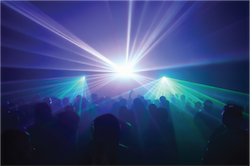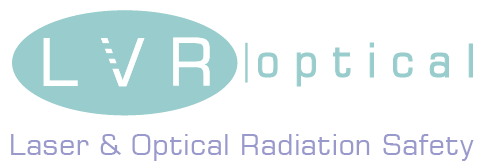
Audience Scanning Laser Effects Workshop

LVR Optical are pleased to introduce a unique hands-on practical workshop for designers and operators of laser effects wanting to produce effects that create safe exposure levels for audience illumination (audience / crowd scanning). The one-day session is designed to follow on from the knowledge gained from the successful Professional Laser Operators Course, for those who are keen to present effects such as safe audience and performer scanning to their clients. The workshop explores a variety of techniques for achieving exciting safe laser effects, with participants gaining direct hands-on experience of designing effects, taking measurements, and evaluating exposure safety.
Led by James Stewart, this highly practical session usually takes place in-house at your workplace where a range of different effects can be created and checked using a selection of standard measurement devices, we bring along for you to use. Attendees will get to see how these tools should be used, and for those that want to, there will be plenty of opportunities to get hands-on time with the instruments taking measurements themselves. There will be chances to try out different techniques to lower the exposure levels of laser effects that exceed the MPE, making them compliant and safe to use. While also understanding how to correctly adjust and test settings such as dwell time and scan velocity featured on controllers such as the Pangolin FB4.
Our new day-long workshop provides attendees with the most in-depth coverage of audience scanning laser effects covering essential topics such as understanding the different types of exposure limits (MPE), what measurement instruments to use and when, and how to set up scan-fail detectors correctly and test their effectiveness.
Checking audience scanning effects is fraught with many issues that can lead to unsafe assessments, James shares his experience and in-depth understanding of this subject to help attendees recognise and avoid the mistakes he has seen others make all too often.
During the workshop, the underlying theory is combined with practical examples of many of the topics; this approach allows attendees to gain valuable knowledge and insight into what is necessary to perform safe and enjoyable laser displays. The workshop is designed and presented by James Stewart, recognised as a leader in assessing and evaluating laser effect exposure in the entertainment industry.
Key topics of the workshop
- Review and further discussion of relevant laser properties and units for laser safety
- A closer look at the different types of MPE, how to apply them, and when they must be considered
- Laser projector & laser effect characteristics important for laser safety
- Scan-fail detectors, how to configure, and going beyond simply just checking they turn the output off
- Measurement devices, in-depth discussion on different types, highlighting the advantages and disadvantages, and how they should be correctly used
- Measuring laser effects, attendees are given the opportunity to experiment with different types of laser effects, checking the output using measurement devices, making adjustments, working with scan-fail parameters, and developing measurement technique
- Review of the day and the exercises completed
Audience Scanning Laser Effects Workshop: Practical application of the IEC 60825 laser safety standards
Course date: Available Now
Presenting the workshop in-house
The workshop can usually be delivered within a work environment at your own premises (both within the UK and overseas locations) - ideal for several staff requiring training at one time. Cost given upon request, and would be per workshop event, with space requirements to enable measurement taking.
To arrange an in-house workshop please email us with your details.
Who should attend this workshop
The workshop is designed for people that already have some previous knowledge and experience in laser shows. The workshop takes steps further than any other laser safety course offered, so for participants to gain the most from it, all attendees must have first attended the Laser Display Safety Training Day. This prerequisite ensures that everyone is equipped with the knowledge required to develop the necessary skills further during the workshop.
Frequently Asked Questions
The discussions on exposure limits, MPE calculation, and other safety management practice, covered in the Operator’s Course is necessary before attending this Audience Scanning Workshop. Attendance of the Professional laser safety training for operators course is therefore a prerequisite to attending the Audience Scanning Laser Effects Workshop.
The workshop has been designed to be highly beneficial to attendees irrespective of their mathematic skills or background. The MPE theory is discussed using a broad approach that describes the principles, with help of easy-to-follow examples. For those interested in delving further there are some brief opportunities to see how to use some of the functions on a scientific calculator such as raising numbers to powers, square roots and pi. But it is by no means essential understand this or apply it if you don’t want to. The mathematics makes only a small part of the day, and there are plenty of other useful topics covered that are beneficial to those wanting to design and check the safety of laser effects.
No. We have a selection of measurement devices that will be used during the day. This gives you the opportunity to see the pros and cons of using different devices, which could help you in selecting your own devices, going forward, based on what you experience in the workshop.
We normally use a standard Kvant ClubMax laser projector as well as Beam Brush projector that has a variable beam width, allowing us to try out a wide range of different audience scanning effects and measurement techniques, while experimenting with additional attachments such as Safety Scan lenses and diffraction effects. The systems have Pangolin’s FB4 and PASS (Professional Audience Scanning System) safety hardware available for us to explore.
We use Pangolin Beyond and Quickshow as the main laser control systems owing to their popularity and likelihood of people being familiar with their features. We don’t necessarily get into any advanced or obscure show programming practices, so the exercises we do should be familiar to users of other laser control software.

